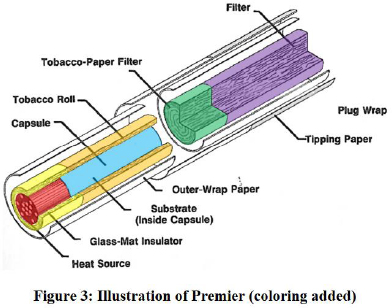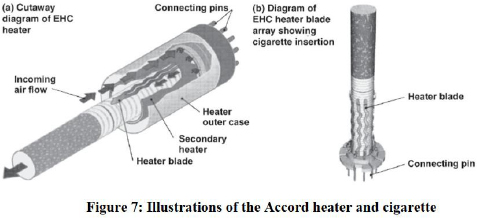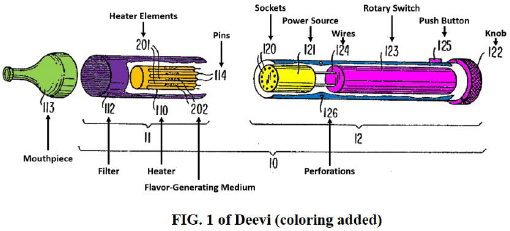Philip Morris Products, SA (a company formed under the laws of Switzerland) v Nicoventures Trading Ltd
| Jurisdiction | England & Wales |
| Judge | Sir Christopher Floyd,Lord Justice Nugee,Lord Justice Arnold |
| Judgment Date | 16 December 2022 |
| Neutral Citation | [2022] EWCA Civ 1638 |
| Docket Number | Case No: CA-2021-000302 |
| Court | Court of Appeal (Civil Division) |
[2022] EWCA Civ 1638
Lord Justice Arnold
Lord Justice Nugee
and
Sir Christopher Floyd
Case No: CA-2021-000302
IN THE COURT OF APPEAL (CIVIL DIVISION)
ON APPEAL FROM THE HIGH COURT OF JUSTICE
BUSINESS AND PROPERTY COURTS OF ENGLAND AND WALES
INTELLECTUAL PROPERTY LIST (ChD)
PATENTS COURT
MR JUSTICE MARCUS SMITH
[2021] EWHC 3032 (Pat)
Royal Courts of Justice
Strand, London, WC2A 2LL
Andrew Lykiardopoulos KC and Tom Alkin (instructed by Powell Gilbert LLP) for the Appellant
Adrian Speck KC and Kathryn Pickard (instructed by Kirkland & Ellis International LLP) for the Respondents
Hearing date: 30 November 2022
Approved Judgment
Introduction
The issue in this appeal is whether the judge, Marcus Smith J, was correct to hold that four patents owned by the appellant, Philip Morris Products SA (“PMI”), were invalid for obviousness. The issue arose in an action brought by Nicoventures Trading Limited, the first respondent, for declarations of invalidity of those patents and in which PMI counterclaimed for infringement against both Nicoventures Trading Limited and the second respondent, British American Tobacco (Investments) Limited. I will refer to the respondents collectively as BAT.
The four patents in suit are all European Patents designating the UK. They are Nos 3,248,483; 3,248,484; 3,248,485; and 3,248,486. The four patents share a common priority date of 29 October 2009 because they were prosecuted as divisional applications from a parent application which was itself divided from a grandparent application. It was common ground before us, as it was before the judge, that the issues can be decided by reference to the current specification and claim of the last of the patents, European Patent (UK) No 3,248,486 (“the 486 patent”).
Since the trial, the 486 patent has been upheld on amended claims before the Opposition Division of the European Patent Office. We are not concerned with those amended claims. The 486 patent stands or falls on the claims which were before the judge. Two of the other patents European Patents (UK) Nos. 3,248,483 and 3,248,485 have been upheld on amended claims. The fourth, European Patent (UK) No. 3,248,484 has been revoked.
The patents are concerned with “heat, not burn” (“HNB”) tobacco products. Conventional, combustible cigarettes allow a smoker to inhale into the lungs an aerosol containing nicotine and other combustion products of tobacco. Whilst the nicotine in the aerosol provides the pleasurable smoking experience, the other combustion products can be harmful. HNB products do not burn the tobacco, but instead heat it to a temperature where it releases the nicotine. The process still produces a nicotine aerosol, and thus gives the pleasurable experience, but is intended to be less harmful than the aerosol produced by combustible cigarettes because it does not contain combustion products. HNB products are to be distinguished from “vaping” products, which simply produce a nicotine aerosol without heating tobacco.
Technical background
For some considerable time before the priority date the tobacco industry had been working on HNB products to a number of different designs. Two products, called the Premier and the Eclipse, were launched by R.J. Reynolds Tobacco Company in the late-1980s and mid-1990s respectively. It is sufficient to show an illustration of the Premier product taken from the expert report of Mr Wensley, BAT's expert witness:

The Premier worked as follows. The smoker lights the heat source (coloured red). The air drawn in by the smoker is heated as it passes through the heat source and in turn heats the aluminium capsule (coloured blue). The heat is transferred to the tobacco roll wrapped around the capsule (coloured orange) and the alumina substrate (coloured blue) during and between puffs. Air is also heated as it enters the glass mat (coloured yellow) and heats the tobacco roll directly. The heat so delivered to the alumina substrate is sufficient to vaporise glycerol, added flavours and natural flavours, including nicotine, from spray-dried tobacco. The hot vapours exit the rear of the capsule and tobacco roll and pass through the tobacco-paper filter (coloured green) where they begin to cool. The less volatile components condense to form very small liquid particles. These small particles and the vapour in which they are entrained form the smoke which passes through to the user. The Premier was a single use device. Neither the Premier, nor the Eclipse which followed it, was a commercial success.
Accord and Heatbar were two later HNB products launched by Philip Morris USA and PMI in the late-1990s and mid-2000s respectively. These devices were intended to be re-usable. They employed electrical heating powered by a battery. A short, cigarette-like stick was inserted into the heating device. The heating device then heated parts of the surface of the cigarette-like insertion sequentially. The figure below, also taken from Mr Wensley's report, shows the features of the Accord heater and insert, which are sufficient for present purposes.

The heater of the Accord device contained an array of heating blades, one blade for each of eight puffs per cigarette. The heater was puff-actuated, and the sequence of blade firing and energy delivery was controlled by electronics. The energy to each blade was delivered in 1.93 s, with different energy rates for two heating phases. In the first heating phase the most rapid heating occurred with 63% of the total energy being delivered in 41% of the heating period. In both phases the energy was metered out in small increments (8 ms pulses), which were delivered at a certain frequency (95 Hz for phase 1; 39.82 Hz for phase 2). Once the user had taken eight puffs, and all eight heaters had been fired, a new consumable cigarette-like insert would be required.
The skilled person and the common general knowledge
The judge held that the skilled person for the purposes of determining the issue of obviousness was a team consisting of a product or heating engineer and a tobacco chemist. He heard evidence from Mr Wensley for BAT who was an experienced product engineer, and from Mr Hopps for PMI who was an experienced tobacco chemist. The judge held that the mode of operation of the Premier/Eclipse and Accord/Heatbar products formed part of the common general knowledge of this skilled team. There is no challenge to any of this.
The judge made extensive further findings as to the content of the common general knowledge. These included:
i) The composition and operation of combustible cigarettes;
ii) That the development of HNB products was desirable because of the perceived health benefits. It was also known that none of the products which had come to market (Premier, Eclipse, Accord and Heatbar) had been commercially successful.
iii) The various types of suitable heater, including resistive heaters.
iv) Thin-film heaters, and in particular Kapton heaters, formed part of the CGK. Kapton is a DuPont trade name for a polyimide developed in the 1960s which formed a flexible substrate onto which conductive material could be printed. Such heaters, it would be known, could be controlled in various ways, including the temperature and duration of heating. Heat could be applied according to some pre-programmed profile, and triggered automatically or through operation of user choice (by pressing a button). Temperature itself could be monitored and controlled by way of a closed loop or feedback control. The evidence showed that thin-film heaters were commonplace for many years up to and beyond the priority date. Uses included heating lab equipment, aircraft, heated optics, outdoor card readers, medical aerosol delivery devices and so on.
v) The skilled person would have known that the arrangement of the various components in the HNB device was very flexible, as the design of the previous devices would have made apparent. The type of product heated was also flexible.
vi) Consistently with the above, sequential heating of portions of the substrate would also have been known.
The pleaded prior art
BAT relied on two items of prior art, of which only one, “Deevi” is material to this appeal. Deevi is US Patent No. 5,322,075, published on 21 June 1994. It was granted to Philip Morris USA. Deevi uses an electrical heater created by printing conductive material onto a flexible substrate. As Deevi explains at column 1 lines 60–62, such heaters can be made using mass-production, printed circuit board manufacturing techniques. The flexibility of the substrate allows the heater to be shaped into a tubular form suitable for incorporating into a smoking article of the same size and shape as a conventional cigarette.
What Deevi describes would be recognised by the skilled person as a thin-film heater. Deevi uses the thin-film heater described to heat a flavour-generating medium in contact with the heater. The flavour-generating medium is deposited on the surface of the heating elements. Once the coating on the heating elements has been vaporised, it cannot be replaced. Deevi's heater is therefore disposable.
The figure below shows Deevi in its simplest form, with colouring added for explanatory purposes:

Deevi's device is in three sections: an optional mouthpiece (113, green); a heater section (11) comprising a heater (110, orange), in which the heating elements (201) sequentially heat different portions of the flavour-generating medium (202) to produce an aerosol; and a power section (12) which contains a power source (121, yellow) and controls.
In operation the user connects section 11 to section 12 via a set of pins...
To continue reading
Request your trial-
Pmi v Bat
...patents to be invalid for obviousness over a document called Deevi: [2021] EWHC 1977 (Pat); and his decision was upheld on appeal: [2022] EWCA Civ 1638. Most recently, HHJ Hacon heard the trial of a case in which BAT asserted a single patent against PMI's IQOS 7 While recognising that I ha......

